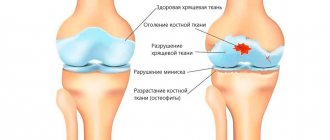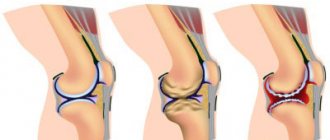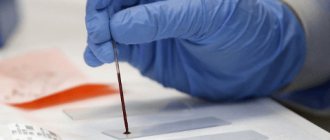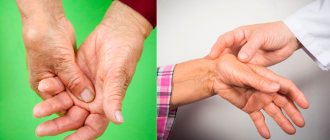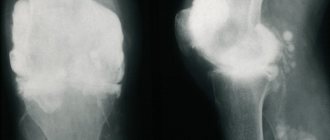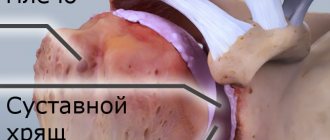Every 3rd patient who comes to a rheumatologist with a complaint of joint inflammation, according to statistics, suffers from infectious arthritis. This disease requires immediate consultation with a doctor, because it can completely and irreversibly destroy a joint in a couple of days, and every 12th of those who are unlucky enough to get the disease die every year from its complications. But if you go to the hospital in a timely manner, 70% of patients get off with a “mild fright” - modern medicine allows you to save joints from deformation in most cases.
Let's look at the symptoms and treatment of infectious arthritis.
Infectious arthritis - what is it?
Infectious arthritis is characterized by an inflammatory process occurring inside the joint. This may be caused by bacteria, viruses, parasites or fungi.
This type of arthritis can affect absolutely any joint.
. A characteristic feature of the disease is that in addition to local manifestations (swelling, pain and joint immobility), there are also general symptoms (fever, chills, signs of intoxication).
Infectious arthritis refers to a group of diseases caused by various types of infectious agents that penetrate specifically into the structure of the tissues that form the joint.
According to existing statistics in the field of rheumatology and traumatology, arthritis of this type is diagnosed in every third patient.
The most common site of infectious arthritis is the joints of the upper and lower extremities
.
Fungal
Most often, fungal infections of the joints develop with actinomycosis, but they also occur with other fungal infections. Pathogenic fungi enter the joint cavity from a nearby bone lesion or from distant lesions (carious teeth) through the bloodstream. The course is chronic, with relapses and the possible addition of a bacterial infection. Very often, fistulas occur - passages through which pus from the joint is released onto the surface of the skin. In the absence of adequate treatment, it leads to a gradual loss of joint function.
Parasitic
The cause of arthritis is usually echinococcosis, which affects the bone tissue of the vertebrae, pelvic bones and long bones of the limbs. A toxic-allergic inflammatory process usually develops in the joints. The joints of the spine, hips, knees and elbows are often involved. The course is benign, but is accompanied by severe joint pain. Recovery occurs when complete treatment of echinococcosis is prescribed.
Infectious-allergic arthritis
Infectious-allergic arthritis occurs when there is an allergy, against the background of which an inflammatory process in the joints develops under unfavorable conditions. The disease occurs in a violent form, accompanied by high fever and severe pain. Redness, swelling, and swelling are observed in the affected area. On different parts of the skin there is a ring-shaped allergic rash. Infectious-allergic arthritis is treated by a rheumatologist and an allergist.
Causes of infectious arthritis
The most likely cause of infectious arthritis is the metastatic route of joint damage, which involves direct penetration of infection into the joint tissue through the blood or lymph.
Another route of infection can be injury or an open wound, as well as the spread of pathogens from nearby foci of another disease, for example, osteomyelitis.
Arthritis caused by infectious pathogens in childhood is usually provoked by staphylococcus, enterobacteria or Haemophilus influenzae. However, at the same time, other arthritis, quite specific for this age category, may occur, caused by tuberculosis, gonorrhea or syphilis.
Signs and symptoms of infectious arthritis
The key symptom of infectious arthritis is considered to be an acute manifestation, accompanied by a large number of symptoms.
Among the main signs and symptoms of infectious arthritis, general symptoms include fever, chills, excessive sweating and a constant feeling of weakness. As an additional symptom, children may experience nausea and vomiting.
Considering the local signs of infectious arthritis, it is worth highlighting:
- sharp pain during palpation/performing movements;
- local redness of the skin, swelling, fever.
It is also worth noting that the clinical picture of arthritis of infectious origin directly depends on the causes of its occurrence. Thus, septic arthritis is often localized in large joints, arthritis of gonococcal etiology is accompanied by multiple rashes, and tuberculous arthritis corresponds to a chronic course.
Particular attention should be paid to the symptoms of viral arthritis: short-term course, the possibility of restoration of articular tissues, without negative consequences
.
General information about the disease
Infectious arthritis is inflammation of a joint caused by a local or general infection. The symptoms of the disease and its course largely depend on the infection that caused the infectious process.
Codes for infectious arthritis according to ICD-10:
- staphylococcal - M00.0;
- pneumococcal - M00.1;
- streptococcal - M00.2;
- caused by other specified bacterial pathogens - M00.8;
- pyogenic unspecified - M00.9;
- tuberculosis – M01.1;
- gonococcal - M01.3;
- viral – M01.5.
The disease is very common and can cause permanent impairment of joint function. A quarter of patients seeking treatment for joint diseases suffer from infectious arthritis.
Stages of development of infectious arthritis
In order to understand how to treat infectious arthritis and what measures will be most effective, it is important to understand at what stage the disease is.
In total, it is customary to distinguish 4 main stages of arthritis:
- Stage 1
– accompanied by the development of osteoporosis (chronically progressive decrease in bone density of the joint), without destructive changes; - Stage 2
– the initial stage of destruction of cartilage tissue, reduction of the joint space, the occurrence of single usurs (destructions on the surface) of the bone; - Stage 3
– significant damage to articular tissues, pronounced reduction in the joint space, the presence of subluxations and deviations (deviations from the norm) of the bones; - Stage 4
– symptoms of stage 3 + complete immobility of the joint.
Types of arthritis of infectious origin
Considering the etiology of the disease, it can be noted that all infectious arthritis have several varieties, including:
- bacterial;
- viral;
- fungal;
- parasitic
.
At the same time, depending on the identified type of disease, the following subtypes of arthritis are also distinguished:
- septic
(pyogenic/purulent); - gonorrheal
; - syphilic
, etc.
Diagnosis of infectious arthritis
Before determining how to treat infectious arthritis, it is important to understand what its etiology is.
(causes of occurrence) and
forecasts
. All the information necessary for this can be determined diagnostically.
Diagnosis of infectious arthritis is carried out by specialists in the field of surgery, traumatology and rheumatology. If necessary, you can also consult an infectious disease specialist or venereologist for advice.
Among the measures used to clarify the diagnosis, it is worth highlighting:
- ultrasound examination of the affected area (ultrasound);
- X-ray examination;
- CT/MRI of the joint.
The disease is diagnosed in people of different ages: from infants to the elderly.
Factory riziku
Factors in the development of septic arthritis:
♦ poor age
♦ blood diabetes
♦ history of arthritis
♦ detection of transplanted cysts
♦ immunodeficiency (liver disease, lymphoma, swelling, deficiency of complement factors, deficiency of immunosuppressors, hypogammaglobulinemia)
♦ internal administration of medications
♦ skin lesions/infections
♦ internal angle injections
♦ illnesses that are transmitted by state paths
Staphylococcus aureus
The most common cause of septic arthritis in non-prosthetic joints is, of course, more important than their repair, which may require arthroplasty. Swells that are previously affected by the inflammatory process, especially rheumatoid arthritis, are the most susceptible to infection.
The most important risk factor for the development of septic arthritis is the presence in the anamnesis of a previous episode of illness, infected with S. aureus.
In this situation, the incidence of infection after total arthroplasty of the knee and knee joint reaches 10% over 3 years and 26% over 10 years. Through reinfection, it is possible to perform up to three repeated operations.
Treatment of infectious arthritis
The primary treatment for arthritis of any type is pain relief
,
antibiotic therapy and
,
of course
,
fever reduction
.
In order to achieve the most effective results, both medicinal and non-medicinal methods can be used as treatment.
All
measures
included in the treatment plan for various types of arthritis
are determined exclusively by the attending physician
, based on the results of a diagnostic examination. In most cases, treatment of infectious joint inflammation is carried out inpatiently.
IMPORTANT! Self-medication can cause the situation to worsen and the consequences to become irreversible.
Physiotherapy as a method of treating infectious arthritis
Physiotherapy
is a unique treatment that can be used both at the treatment stage and for rehabilitation purposes after radical measures.
Among the most effective measures it is customary to highlight:
- magnetic therapy;
- use of amplipulse or sinusoidally modulated currents;
- electrophoresis (introduction of drugs into joint tissues through exposure to electric current);
- laser or ultrasound therapy;
- local exposure to paraffin or ozone.
Massage as a method of treating infectious arthritis
Massage
– a great way to improve/restore blood circulation to the affected joint. Despite its usefulness, you should resort to this method only after consultation with your doctor.
To treat various types of arthritis, the following types of massage can be used:
- local
– concentrated on a specific area of the human body;
- general
– the use of massage techniques is distributed throughout the body.
It is important to note that massage cannot be the only treatment for arthritis.
. Only an integrated approach, involving the use of drug treatment in tandem with physiotherapeutic methods, massage and specialized exercises, can give a chance for complete tissue restoration and elimination of the symptoms of the disease.
Exercise therapy as a method of treating infectious arthritis
Physiotherapy
– a special method of treating arthritis of various types, in particular those caused by infectious diseases.
Various types of exercises and static positions are an effective means of not only treating, but also preventing diseases of joint tissues.
A set of gymnastic exercises allows you to achieve stable remission and minimize pain, swelling and pathological tension of muscle tissue.
Use of drugs in the treatment of infectious arthritis
Drug therapy in the treatment of arthritis is a fairly effective method that has the desired effect on the patient’s body. In case of timely application of a well-chosen treatment plan, it can be stated that the prescribed therapy is successful
.
As part of treatment, taking into account the causes and characteristics of the course of the disease, various types of antibiotics
, as well as other groups of drugs. Let's look at some of them in detail.
Chondroprotectors in the treatment of infectious arthritis
Chondroprotectors
- This is a group of long-acting drugs, the use of which is necessary for several months.
Prescribing a course of drugs of the presented type allows you to create favorable conditions for the restoration of articular tissues, which significantly affects the patient’s quality of life, due to the restoration of the functionality of the affected joint
.
The most effective drug of the group of chondroprotectors is considered to be “ Structum”
».
Antispasmodics in the treatment of infectious arthritis
Use of antispasmodics
provides the opportunity to relieve patients from muscle pain that occurs as a result of joint damage.
Among the frequently prescribed ones, it is worth highlighting “ Drotaverine
».
Nonsteroidal anti-inflammatory drugs in the treatment of infectious arthritis
Nonsteroidal anti-inflammatory drugs
(NSAIDs) are excellent helpers in the treatment of arthritis. The action of drugs of this type allows the patient to get rid of pain.
The frequency, duration of use and dosage are determined by the attending physician, based on the existing clinical picture.
One of the most effective drugs of this type is “ Artradol
».
Surgical method of treatment
In a situation where complex therapy is unable to cope with the existing degree of damage to the joint, radical methods come to the rescue, including surgery.
Surgical treatment of arthritis is used only in severe cases. Among the types of surgical intervention there are such measures as:
- arthroscopy
is a low-traumatic operation that involves the removal of bone processes; - endoprosthetics
– replacement of articular elements with implants; - arthrodesis
– absolute fixation of the joint; - osteotomy
- excision of part of the bone tissue of the affected joint in order to reduce pressure on it; - arthroplasty
is a complete replacement of the affected joint.
Forecasts and prevention of infectious arthritis
Considering the prognosis of the disease, it is worth noting that only one third of patients with arthritis of infectious origin at the end of treatment are faced with unpleasant residual effects, which are expressed by joint immobility.
The most dangerous types of the disease are septic arthritis, because despite fairly favorable prospects, the fatal outcome is 5-15%
.
The risk group for developing infectious arthritis includes people of different ages who have ailments such as:
- rheumatoid arthritis;
- osteoarthritis;
- bad habits;
- weakened immune system;
- obesity of varying degrees.
For the purpose of prevention, it is recommended to follow the basics of dietary nutrition, attend prescribed therapeutic events, promptly treat existing diseases and, of course, monitor the general health of the body.
Advantages of the Mama Papa Ya clinic
The network of family clinics “Mama Papa Ya” offers the service of consultation with a rheumatologist and diagnosis of various types of arthritis. An experienced doctor will be able to identify the cause of the disease and explain how to treat arthritis.
Advantages of our clinic:
- working with patients of different ages;
- versatility;
- a network of branches in Moscow for ease of visiting;
- affordable prices for diagnostic procedures and consultations with doctors;
- experienced staff;
- individual approach to each patient, taking into account all the characteristics of his health.
Reviews
Good clinic, good doctor!
Raisa Vasilievna can clearly and clearly explain what the problem is. If something is wrong, she speaks about everything directly, not in a veiled way, as other doctors sometimes do. I don’t regret that I ended up with her. Anna
I would like to express my gratitude to the staff of the clinic: Mom, Dad, and me. The clinic has a very friendly atmosphere, a very friendly and cheerful team and highly qualified specialists. Thank you very much! I wish your clinic prosperity.
Anonymous user
Today I had a mole removed on my face from dermatologist I.A. Kodareva. The doctor is very neat! Correct! Thanks a lot! Administrator Yulia Borshchevskaya is friendly and accurately fulfills her duties.
Belova E.M.
Today I was treated at the clinic, I was satisfied with the staff, as well as the gynecologist. Everyone treats patients with respect and attention. Many thanks to them and continued prosperity.
Anonymous user
The Mama Papa Ya clinic in Lyubertsy is very good. The team is friendly and responsive. I recommend this clinic to all my friends. Thanks to all doctors and administrators. I wish the clinic prosperity and many adequate clients.
Iratyev V.V.
We visited the “Mama Papa Ya” Clinic with our child. A consultation with a pediatric cardiologist was needed. I liked the clinic. Good service, doctors. There was no queue, everything was the same price.
Evgeniya
I liked the first visit. They examined me carefully, prescribed additional examinations, and gave me good recommendations. I will continue treatment further; I liked the conditions at the clinic.
Christina
The doctor carefully examined my husband, prescribed an ECG and made a preliminary diagnosis. She gave recommendations on our situation and ordered additional examination. No comments so far. Financial agreements have been met.
Marina Petrovna
I really liked the clinic. Helpful staff. I had an appointment with gynecologist E.A. Mikhailova. I was satisfied, there are more such doctors. Thank you!!!
Olga
Recommendations for infectious arthritis
To maintain the effectiveness of therapy, as well as achieve the most favorable results, it is important to follow a number of recommendations for infectious arthritis, including:
- Movement is an integral part of therapy.
- Maximum limitation of sudden movements and forces that create additional stress on the affected joints.
- Improving power sensations.
- Simplifying everyday processes through the use of modern technological solutions.
- Increasing personal safety by installing additional handrails in the apartment, using anti-slip mats, etc.
The most widespread daily news
Table 2 shows the most widespread clinical manifestations characteristic of early cases of septic arthritis. Many rare etiological causes of septic arthritis have been described, so always focus on the most common pathogens, especially S. aureus,
which can be completely destroyed in 2-3 days.
The localization of the affected lump is of great diagnostic importance. Thus, purulent arthritis of nongonococcal gait in 85–90% of seizures affects only one joint. In case of polyglobular infection, Staphylococcus aureus is most often identified,
Other etiological causes may also include gonorrhea, various viral infections, Lyme disease, reactive arthritis, and various inflammatory processes of non-infectious diseases. Group B streptococci often infect the sacral club and sternoclavicular joints. Reactive arthritis in most seizures asymmetrically affects the greater joints. Viral arthritis is characterized by a symmetrical distribution of the joint joints, especially the hands, with joint joints. In tuberculous arthritis, fluctuation during palpation of the cyst should be avoided.
Features of nutrition during treatment and prevention of infectious arthritis
Therapeutic nutrition for arthritis of various types is aimed primarily at normalizing the immune response, as well as weakening inflammatory processes, in order to restore the range of motion of the affected joint.
Nutritional features depend on:
- stages of disease development;
- presence of concomitant diseases;
- severity of clinical manifestations.
Based on this, we can come to the conclusion that there is no single diet. However, there are a number of general principles for creating a diet, including:
- fractional meals;
- preference for certain types of culinary food processing (boiling/baking/steaming/stewing);
- food intake temperature – no more than 60°C;
- limiting salt and liquid intake;
- giving up bad habits;
- saturating the diet with vitamins.
YOU can call us: 8 (8452) 98-84-68 and +7-967-500-8468 or
Reactive arthritis is an inflammatory disease affecting the joints that develops after suffering certain infections (genitourinary, intestinal, nasopharyngeal).
The disease belongs to the group of seronegative spondyloarthritis. In most cases it is associated with acute or persistent intestinal (caused by Enterobacteriaceae) or urogenital chlamydial infection, but can also be associated with respiratory tract infections caused by mycoplasmas and chlamydia. There is evidence of a possible connection with some parasitic diseases.
A complex of symptoms including arthritis, conjunctivitis, urethritis or cervicitis, colitis and characteristic skin lesions is called Reiter's syndrome.
History The term “reactive arthritis” was first introduced by Finnish scientists K. Aho, K. Sievers and R. Ahvonen, who in 1969 described the occurrence of arthritis in enterocolitis caused by Yersinia. At the same time, the “reactive”, sterile nature of arthritis was emphasized and it was believed that there were no infectious agents and their antigens in the synovial fluid and synovial membrane.
Later, with the development of imaging and laboratory diagnostic methods, intracellular inclusions of Chlamydia trachomatis, microbial DNA and RNA fragments, as well as circulating immune complexes were discovered in the joint environment of patients. Later it was found that normally the joint is not sterile, and various microorganisms are often present in it.
As we studied, a close relationship between reactive arthritis and the HLA-B27 antigen was revealed. It has been found that antibodies to a number of microorganisms cross-react with HLA-B27 and can damage the body's own tissues during the immune response.
Etiology Today, the ability to cause reactive arthritis has been identified in many microorganisms:
Pathogens of intestinal infections: Yersinia enterocolitica Yersinia pseudotuberculosis Salmonella enteritidis Salmonella typhimurium Shigella flexneri Shigella sonnei Shigella Newcastle Campylobacter jejuni Clostridium difficile Pathogens of urogenital infections: Chlamydia trachomatis Pathogens of respiratory tract infections: Mycoplasma pneumoniae Chlamydophila pneumoniae
Epidemiology After a chlamydial urogenital infection, reactive arthritis develops in 1 - 3% of cases. After intestinal - in 1.5 - 4% of cases. People aged 20 to 40 years old, most often men, become ill. Urogenital reactive arthritis occurs in men 20 times more often than in women, enterocolitic arthritis occurs 10 times more often.
There is evidence that carriers of the HLA-B27 antigen develop arthritis 50 times more often after an intestinal or chlamydial infection than those who do not have this antigen.
Pathogenesis In the development of reactive arthritis, the phenomenon of cross-reaction of antibodies to the pathogen with the HLA-B27 antigen of the host's major histocompatibility complex has been revealed. A possible explanation for this is the theory of “molecular mimicry” - the structural similarity of proteins in the cell wall of bacteria with proteins in the cells of a sick person.
There are several immunological hypotheses for the pathogenesis of reactive arthritis.
Antigen-presentation hypothesis: according to it, the HLA-B27 complex is capable of presenting microbial peptides that cause arthritis. By interacting with cytotoxic CD8 T lymphocytes, they cause lysis of cartilage cells and an inflammatory process. Disorders of heavy chain assembly of the HLA-B27 antigen: proposed in 2000 by RA Colbert et al. According to it, under the influence of polysaccharides of microbial cells, the synthesis of heavy chains of the HLA-B27 antigen is disrupted. This leads to disruption of macrophage activity, reduces the effectiveness of their immune response and destruction of bacterial cells, and can lead to the development of inflammation in the joint. Cytokine hypothesis. Proposed by J. Sieper in 2001. Based on studies showing cytokine imbalance in patients with reactive arthritis. A decrease in the Th1 immune response (production of IF-γ, TNF-α, IL-2 and IL-12) in favor of a Th2 immune response (synthesis of IL-4 and IL-10) was revealed. At the same time, in the macrophages of the synovial fluid, the production of IF-γ and TNF-α decreases and the production of IL-4 increases, which contributes to the persistence of bacteria in the joint. This hypothesis is under development and has not yet been fully formulated. Currently, the concept of reactive arthritis as sterile has lost its relevance. One of the important advances in the study of reactive arthritis at present is that arthritis-initiating microorganisms, in particular chlamydia, disseminate into the joint. Proof of this is the detection of viable chlamydia in the joint membrane and joint fluid by nucleic acid amplification. Despite this, during routine diagnostics it is almost impossible to isolate chlamydia from a joint. It is believed that chlamydia is “recruited” into the joint by the synovial membrane as part of macrophages and dendritic cells. The latter probably stimulate a specific T-cell immune response directly in the joint. This is confirmed by the fact that the synovial membrane consists of 50% macrophages, so that in the joint, as a rule, the capture of certain particles from the bloodstream is inevitable. More often this occurs in large and medium-sized joints (knees, ankles), which are subject to microtrauma as a result of the fact that they bear a supporting load. According to various authors, chlamydia is determined in the joint with subsequent cultivation in developing chicken embryos and in living cells in more than half of the cases (53%). During cultivation, both typical and L-forms are determined. Both of them, therefore, can persist in the synovium.
Clinical picture Joint damage: Develops within a month after the infection. Mostly large joints of the lower extremities (knees, ankles, big toes) are affected on one side. Other joints may also be involved, rarely more than six, and arthritis of the sacroiliac joints (sacroiliitis) and the overlying parts of the spine often occurs. Damage to the tendons: Along with the joints, the tendons, at the place of their attachment to the bone, and the tendon bursae of the toes and hands are often affected with the development of dactylitis. Damage to the mucous membranes: Conjunctivitis - often oligosymptomatic or asymptomatic, short-term. Non-infectious urethritis, annular balanitis, cervicitis, oral erosions, and uveitis may develop. Skin lesions: Keratoderma (keratoderma blennorrhagica) is a painless keratinization of the skin with rashes in the form of papules and plaques, most often on the plantar part of the feet and palms. Nail damage: More often detected on the toes: yellow discoloration, peeling and destruction of the nail. Systemic manifestations: Enlarged lymph nodes, especially inguinal ones. Pericarditis, myocarditis, leading to cardiac conduction disturbances; aortic valve insufficiency, pleurisy, kidney inflammation (glomerulonephritis). Possible development of polyneuritis. Reiter's syndrome Main article: Reiter's syndrome A classic manifestation of reactive arthritis, it combines the “Reiter's triad”: damage to the joints (arthritis, synovitis), eyes (conjunctivitis, uveitis), and mucous membranes of the genitourinary organs (urethritis). In the case of the addition of skin manifestations (keratoderma), it is called “Reiter's tetralogy”. It was first described by Benjamin Brody, and then in 1916 by the German military doctor Hans Conrad Reuther in a soldier who had suffered from dysentery.
Currently considered as a special form of reactive arthritis. The disease begins 2 - 4 weeks after a chlamydial or intestinal infection, most often with damage to the urogenital tract. The most common triggering agents are Chlamydia trachomatis and Shigella flexneri 2a, as well as their combination.
Diagnostics Diagnostic criteria Criteria of the III International Meeting on Reactive Arthritis (Berlin, 1996):
Peripheral arthritis : Asymmetric Oligoarthritis (affects up to 4 joints) Predominantly affecting the joints of the legs Infectious manifestations: Diarrhea Urethritis Occurrence 2-4 weeks before the development of arthritis Laboratory confirmation of infection: In the presence of clinical manifestations of infection - desirable In the absence of obvious clinical manifestations of infection - mandatory Exclusion criteria - an established cause of the development of mono- or oligoarthritis: Spondyloarthritis Septic arthritis Crystalline arthritis Lyme disease Streptococcal arthritis Differential diagnosis Septic arthritis: occurs in the form of monoarthritis. It is characterized by high leukocytosis of synovial fluid (20,000-100,000/μl), positive results of bacterial culture. Viral arthritis can be caused by rubella viruses, parvovirus, adenovirus, hepatitis B virus, herpes viruses of various types, mumps virus, enteroviruses, Coxsackie viruses, etc. History often shows a connection with a viral infection or vaccine. In the clinic, the syndrome is more pronounced: arthralgic syndrome (joint pain) than arthritic syndrome (swelling, hyperemia). Within 1-2 weeks, symptoms disappear without residual effects. Poststreptococcal arthritis : appears against the background or 1-2 weeks after a streptococcal infection, characterized by simultaneous involvement of the middle joints, an increase in the titer of anti-streptococcal antibodies. Patients often have chronic foci of infection in the nasopharynx (tonsillitis, pharyngitis, sinusitis). The effect of NSAIDs may be delayed, and the improvement in laboratory parameters is insignificant. Rheumatoid arthritis : the clinic differs. There are no special markers. With reactive arthritis, inflammation of the tendons occurs and a common symptom is heel pain. It is difficult to differentiate in the case of the onset of oligoarthritis in young people, asymmetry of lesions and seronegativity. A thorough search for trigger infections and dynamic monitoring are required. Ankylosing spondylitis : The only difference is the x-ray of the SIJ (sacroiliac joint) and hip joints: if sacroiliitis is unilateral or absent, then reactive arthritis (RA), and if bilateral, at least stage 2, or unilateral, at least stage three, then Ankylosing spondylitis. But this is not suitable for early diagnosis, since these changes appear only after several years of illness. There is every reason to believe that prolonged reactive arthritis will develop into Ankylosing spondarthritis, and may be considered a certain stage in the development of the disease. Psoriatic arthritis : Difficulties arise when arthritis develops before skin symptoms appear. To exclude reactivity, a search for trigger infections and monitoring over time is carried out. Lyme disease : has a characteristic epidemiological history: stay in endemic areas, tick bite. Antibodies to the genus Borrelia are detected in the blood. Tuberculous arthritis : there are general symptoms of tuberculosis: intoxication syndrome, low-grade fever, autonomic disorders. Joint pain, mainly at night, symptoms of arthritis. The diagnosis is confirmed by x-ray data, analysis of synovial fluid, and biopsy of the synovial membrane. Laboratory diagnostics Mandatory tests include: a general blood test, urine test, detection of chlamydia and antibodies to them, testing for the presence of HIV infection, gonococci, stool testing for Salmonella, Shigella, confirmation of the absence of antinuclear antibodies and rheumatoid factor.
Study for the result: Complete blood count: leukocytosis, increased ESR, normochromic anemia. General urine analysis: possible proteinuria, microhematuria, leukocyturia AT, PCR: often positive for chlamydia AT: positive for gonococci only in case of mixed infection Stool analysis: Possible detection of Salmonella, Shigella Antinuclear AT: Absent Rheumatoid factor: Absent Additional studies include analysis of synovial tissue liquids. Signs of a reliable diagnosis of reactive arthritis are: low viscosity of the synovial fluid, poor formation of a mucin clot, leukocytosis (5000-10,000/μl) with a predominance of segmented neutrophils. Unlike septic arthritis, a decrease in glucose concentration is uncharacteristic.
Instrumental studies Mandatory: X-ray examination of the affected joints. Characteristically: changes can be noticed only with a long course of the disease; it is possible to detect unilateral sacroiliitis, more often in carriers of the HLA-B27 antigen. Gross changes in bone and cartilage, ossifications are uncharacteristic.
Additional : echocardiography (detection of damage to the aortic valves).
Treatment The outcome of the disease is closely related to the destruction (eradication) of the pathogen, which is why long-term use of antibacterial drugs is necessary. The goals of symptomatic treatment are to eliminate pain and inflammation in the joints.
Treatment is usually carried out on an outpatient basis; cases of severe arthritis with systemic manifestations and unclear cases requiring clarification of the diagnosis require hospitalization.
Non-drug treatment A motor regimen is indicated: rest of the affected limb during the first two weeks of the disease, but joint fixation and immobilization are not indicated. Cold on the affected joint. In the future, exercise therapy is prescribed according to an individual plan. There is no need to adhere to a special diet.
Drug therapy 1. Antibacterial therapy is of paramount importance in case of detection of chlamydial infection and is carried out for a long time. There are mainly three groups of drugs used that act on intracellular microorganisms: macrolides, fluoroquinolones and tetracyclines.
Drugs of choice:
Doxycycline 0.3 g per day, orally in 2 doses for 30 days; Azithromycin 1 g per day on the first day, then 0.5 g/day orally for 30 days; Clarithromycin 0.5 g per day, orally in 2 doses for 30 days; Spiramycin 9 IU per day, in 3 doses for 30 days. Second-line drugs (in case of intolerance or ineffectiveness of the above drugs):
Ofloxacin 600 mg per day orally in 2 doses for 30 days; Ciprofloxacin 1500 mg per day, orally in 2 divided doses for 30 days; Lomefloxacin 400-800 mg per day, orally in 1-2 doses for 30 days. In the case of enterocolitis, the effectiveness of antibiotics has not been proven.
2. NSAIDs - have a symptomatic effect: relieve pain and inflammation of the joints.
Diclofenac orally 2-3 mg/kg/day in 2-3 divided doses; Naproxen orally 15-20 mg/kg/day in 2 divided doses; Ibuprofen orally 35-40 mg/kg in 2-4 doses; Nimesulide orally 5 mg/kg in 2-3 doses; Meloxicam orally 0.3-0.5 mg/kg in 1 dose. Without exception, all NSAIDs have a negative effect on the stomach and kidneys! Therefore it is necessary to use the smallest possible dose.
When taking NSAIDs, you should monitor your blood tests to monitor your kidneys and liver. It is also necessary to use drugs to protect the stomach (Omeprozole...)
3. Glucocorticoids - for severe arthritis, they are used for intra-articular administration. A necessary condition is the exclusion of septic arthritis.
4. Immunosuppressors - used for severe and protracted course, signs of spondyloarthritis, high activity of arthritis.
Sulfasalazine 2 -3 / g/day. Methotrexate 7.5-15 mg/week. (Not used in modern treatment of reactive arthritis. Not a drug of choice since it has not shown effectiveness in studies in the group of seronegative spondiarthritis) Azathioprine 150 mg/day (Not used in modern treatment of reactive arthritis. Not a drug of choice since it has not shown effectiveness in studies in the group of seronegative spondiarthritis)
Course and prognosis The duration of the primary case is on average 3-6 months. Symptoms often persist for up to 12 months or more. There is a greater tendency to develop relapses in patients with Reiter's syndrome, both due to the possibility of reinfection and persistence of chlamydial infection.
The outcome of acute to chronic arthritis is observed in 20-50% of patients. In 15% of cases, severe joint dysfunction develops. The most severe course of reactive arthritis occurs in HIV-infected patients.
The period of temporary disability in acute cases is 30-60 days, in subacute cases 35-65 days, in case of exacerbation of chronic cases - 30-35 days.
With a protracted course of reactive arthritis, there is a high probability of its transition to one of the chronic diseases of the group of seronegative spondiarthritis (Ankylosing spondylitis)
Prevention Prevention of reactive arthritis comes down to preventing the infections that cause it: maintaining a hygienic regime regarding intestinal infections, boiling water, washing hands, following the rules of storing and preparing food. People who have a positive HLA-B27 antigen are recommended to take prophylactic antibiotics while traveling (norfloxacin 0.4 g 2 times a day). To prevent chlamydia, protective equipment is used during casual sexual contact.
